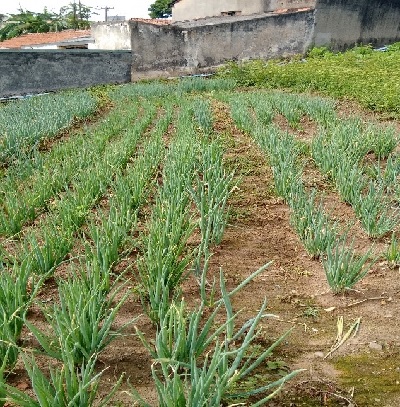Performance of chive cultivars in two harvest seasons
DOI:
https://doi.org/10.20873/jbb.uft.cemaf.v10n3.belfortKeywords:
Allium schoenoprasum L , competition, phenology, age, yieldAbstract
Compulsory component of the popular Green Smell in any quadrant of the National territory, Chives need to diversify crops to increase productivity especially in small crops of family farming. In light of the above objective was to evaluate the performance of Ibirité cultivars Nebuka and Todo Ano, making it where two moments of harvest. For this research was conducted in the experimental area of the Department of Plant Science, the Agricultural Sciences Center (UFPI) between March and July 2019, in a randomized complete block design with three replications, being the treatments in a 3x2 factorial arrangement, the first cultivar factor and the second harvest season (8th and 10th after planting), are considered parameters: height, tillers number per plant, root depth, false stem length; average weight of the whole plant, root, pseudostem and leaves. The results showed that the Ibirité and Todo Ano cultivars presented similar behavior, with superiority of the second as the ability to affiliate. The Nebuka is superior to others, producing nearly twice the fresh weight in the same period, tillering without registration. Regardless of cultivating the harvest season begins in the 8th. week, extending to the 10th. week, without compromising product quality.
References
Belfort CC, Macedo APS, Nery EB. Determinação do ponto de colheita na cebolinha (Allium schoenoprasum). In: Re-sumos VIII Seminário de Iniciação Científica da Universi-dade Federal do Piauí/V Encontro de Pesquisadores. Teresi-na: UFPI. p.129, 1999.
Belfort CC. (2001). Influência do peso do perfilho no compor-tamento da cebolinha. In: Horticultura Brasileira, Brasília, CD-ROM.
Belfort CC, Nery EB, Setúbal JW, Thé FW, Silva Filho, JAS, Macedo ZP. (2003). Efeito de tipos de bandeja e idades de transplantio na produção de mudas de Cebolinha (Allium schoenoprasum L.). In: Horticultura Brasileira, Brasília, CD-ROM.
Belfort CC, Paixão ABA, Nery EB, Nolêto AS, Sousa Neto FA, Lima TR. Desempenho de mudas de cebolinha após seis meses de estresse em bandejas de poliestireno expandi-do. Agropecuária Científica no Semiárido, v.17, n.2, p.78-83, 2021a. http://dx.doi.org/10.30969/acsa.v2i17.1287
Belfort CC, Santos FS, Paixão ABA, Nery EB, Noleto AS, Lima TR. Identificação do ponto de colheita na cebolinha “Todo Ano”. Agropecuária Científica no Semiárido, v.17, n.2, p.84-88, 2021b.http://dx.doi.org/10.30969/acsa.v17i2.1288
Boff P, Debara JF. Tombamento e vigor de mudas de cebola em função de diferentes profundidades e densidades de se-meadura. Horticultura Brasileira, v.17, p.15-19, 1999.https://doi.org/10.1590/S0102-05361999000100005
Ferreira DF. Sisvar: a Guide for its Bootstrap procedures in multiple comparisons, Ciência e Agrotecnologia, v.38, n.2, p.109-112, 2014. https://doi.org/10.1590/S1413-70542014000200001
Filgueira FAR. Novo manual de olericultura: agrotecnologia moderna na produção e comercialização de hortaliças. Viço-sa: UFV, 402p. 2008.
Gomes FP. Curso de Estatística Experimental. 11. ed. Nobel, Piracicaba, SP, 451p. 2009.
Makishima NO. Cultivo de hortaliças. Brasília: Embrapa, 8. Ed, 108p. 1993.
Santos JMD, Pegoraro RF, Pereira PR, Fagundes JL, Mistura C, Agostini MA, Fontes PCR. Comportamento da cebolinha cultivadas sob diferentes níveis de cloreto de potássio em solução nutritiva. Revista Ceres, v.52, n.303, p.729-738, 2005.
Sementes Horticeres (2019) Linha de produtos. Disponível em: https://www.horticeres.com.br/linhas-de-produtos/. Acessado em Abril, 2022.
Silva DRG, Rodrigues L, Macedo FS, Carlos L, Veiga AD, Faquin V, Souza MAS. Desenvolvimento de cebolinha em cultivo hidropônico em função de doses de boro e zinco. Magistra, v.22, n.1, p.64-70, 2010.

Downloads
Published
How to Cite
Issue
Section
License
Copyright (c) 2022 Cristóvam Colombo Belfort, Lucas Micolas Silva Carvalho, Andressa Borges de Almeida Paixão, Ânderson Silva Nolêto

This work is licensed under a Creative Commons Attribution 4.0 International License.
Copyright (c) 2024 - Journal of Biotechnology and Biodiversity

This work is licensed under a Creative Commons Attribution 4.0 International License.
Authors who publish with this journal agree to the following terms:
Authors retain copyright and grant the journal right of first publication with the work simultaneously licensed under a Creative Commons Attribution License (CC BY 4.0 at http://creativecommons.org/licenses/by/4.0/) that allows others to share the work with an acknowledgement of the work's authorship and initial publication in this journal.
Authors are able to enter into separate, additional contractual arrangements for the non-exclusive distribution of the journal's published version of the work (e.g., post it to an institutional repository or publish it in a book), with an acknowledgement of its initial publication in this journal.
Authors are permitted and encouraged to post their work online (e.g. in institutional repositories or on their website) prior to and during the submission process, as it can lead to productive exchanges, as well as earlier and greater citation of published work (Available at The Effect of Open Access, at http://opcit.eprints.org/oacitation-biblio.html).


